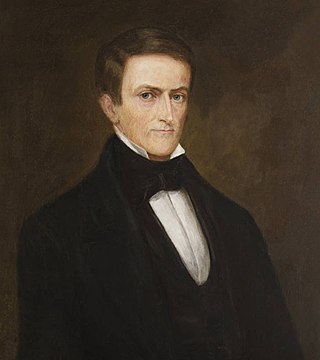
John Anthony Winston was a planter, military officer, and politician who became the 15th Governor of Alabama after serving as president of the state senate (1845–1849). Alabama's first native-born governor, Winston later fought for the Confederate States of America as colonel of the 8th Alabama Infantry early in the American Civil War, and after the conflict was not permitted to assume a seat in the United States Senate.

The 2006 Alabama gubernatorial election occurred on November 7, 2006. Incumbent Republican Governor Bob Riley defeated Democratic Lieutenant Governor Lucy Baxley. Riley garnered 21% of African Americans' votes.

United States gubernatorial elections were held on November 5, 2002, in 36 states and two territories. The Republicans won eight seats previously held by the Democrats, as well as the seat previously held by Minnesota governor Jesse Ventura, who was elected on the Reform Party ticket but had since renounced his party affiliation. The Democrats won 10 seats previously held by the Republicans, as well as the seat previously held by Maine governor Angus King, an independent. The elections were held concurrently with the other United States elections of 2002.

United States gubernatorial elections were held on November 3, 1998, in 36 states and two territories. Going into the election cycle, 24 of the seats were held by Republicans, 11 by Democrats, and one by an Independent. The elections changed the national balance of power by the loss of one Republican and the gain of one Independent, although political party dominance was shifted in nine states. Democrats gained open seats in California and Iowa and defeated incumbents Fob James of Alabama and David Beasley of South Carolina, while Republicans won open seats in Colorado, Florida, Nebraska, and Nevada and the Reform Party won an open Republican governorship in Minnesota. By the end of the election, 23 seats were held by Republicans, 11 by Democrats, one by the Reform Party, and one by an Independent.
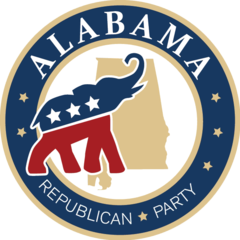
The Alabama Republican Party is the state affiliate of the Republican Party in Alabama. It is the dominant political party in Alabama. The state party is governed by the Alabama Republican Executive Committee. The committee usually meets twice a year. As of the February 23, 2019 meeting in Birmingham, the committee is composed of 463 members. Most of the committee's members are elected in district elections across Alabama. The district members are elected in the Republican Primary once every four years, with the most recent election for the committee having been on June 5, 2018. The new committee takes office following the general election in November 2018. In addition, all 67 county GOP chairmen have automatic seats as voting members. The state chairman can appoint 10 members. Each county committee can appoint bonus members based on a formula that theoretically could add 312 seats, although that formula currently calls for only about 50 seats.

The 1970 Alabama gubernatorial election was marked by a competitive Democratic primary battle between incumbent moderate Governor Albert Brewer and segregationist former governor and 1968 independent presidential candidate George Wallace. The Alabama Constitution was amended in 1968, allowing a governor to serve two consecutive terms.

The 1982 Alabama gubernatorial election was held on November 2, 1982, to elect the governor of Alabama. Incumbent Democrat Fob James declined to run for re-election; he later successfully ran again in 1994 as a Republican. The open seat election saw former Democratic governor George Wallace, who narrowly won the Democratic primary, defeat Republican Emory Folmar, the Mayor of Montgomery, Alabama.

The 1958 Alabama gubernatorial election was held on November 4, 1958. Incumbent Democrat Jim Folsom was term limited and could not seek a second consecutive term.
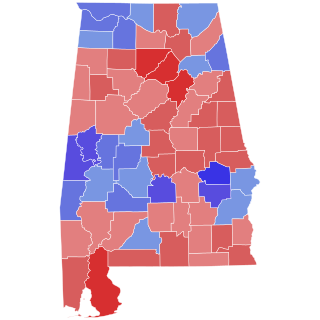
The 1986 Alabama gubernatorial election saw the election of Republican H. Guy Hunt over Democrat Bill Baxley. In state politics, this election is largely seen as a realigning election since Hunt was the first Republican to be elected governor in 114 years – the last Republican to be elected was David P. Lewis in 1872 during the Reconstruction era. In March 1986, incumbent George Wallace announced that he would not seek a fifth term as governor, ending an era in Alabama politics.

The 2010 Alabama gubernatorial election took place on November 2, 2010. Incumbent Governor Bob Riley was term-limited and unable to seek re-election. The party primaries were held on June 1, 2010, with a Republican runoff on July 13. In the general election, Robert J. Bentley defeated Democrat Ron Sparks. This was the first election in which Republicans won three consecutive gubernatorial elections in the state. This was also the first time since Reconstruction that a Republican carried Colbert County, Franklin County, and Lawrence County in a gubernatorial race.

Elections in Alabama are authorized under the Alabama State Constitution, which establishes elections for the state level officers, cabinet, and legislature, and the election of county-level officers, including members of school boards.

The 1978 Alabama gubernatorial election took place on November 7, 1978, to elect the governor of Alabama. Fob James, a businessman who had switched from the Republican Party to the Democratic Party and campaigned as a "born-again Democrat", won the Democratic primary in an upset over Attorney General Bill Baxley. He went on to defeat Guy Hunt in a landslide in the general election. Incumbent Democrat George Wallace was term limited and could not seek a third consecutive term; he later successfully ran again in 1982.

The 1966 Alabama gubernatorial election took place on November 8, 1966, and resulted in the election of Lurleen Wallace as the governor over U.S. Representative James D. Martin. Incumbent Democrat George Wallace was term limited and could not seek a second consecutive term; he later successfully ran again in 1970 and 1974 before being term-limited again, and then successfully ran again in 1982.

The 1857 Alabama gubernatorial election took place on August 3, 1857, in order to elect the governor of Alabama. Democrat Andrew B. Moore won his first term as governor. Moore ran unopposed in the general election. Incumbent John A. Winston did not run because he was term-limited.
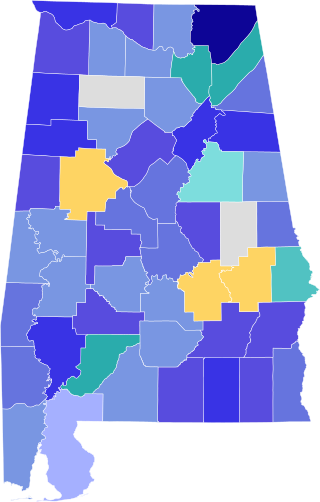
The 1853 Alabama gubernatorial election took place on August 1, 1853, in order to elect the governor of Alabama. Democrat John A. Winston won his first term. Henry W. Collier did not run because he was term-limited.

The 2022 Alabama gubernatorial election took place on November 8, 2022, to elect the governor of Alabama. Incumbent Governor Kay Ivey took office on April 10, 2017, upon the resignation of Robert J. Bentley (R) and won a full term in 2018. In 2022, she won her bid for a second full term in a landslide.

The 1831 Alabama gubernatorial election was an election held on August 1, 1831, to elect the governor of Alabama. Jacksonian candidate John Gayle beat the incumbent Jacksonian governor Samuel B. Moore and National Republican candidate Nicholas Davis with 55.01% of the vote.
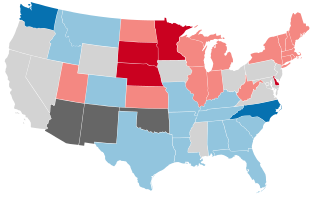
United States gubernatorial elections were held in 1900, in 34 states, concurrent with the House, Senate elections and presidential election, on November 6, 1900.

United States gubernatorial elections were held in 1896, in 32 states, concurrent with the House, Senate elections and presidential election, on November 3, 1896.

The 2022 Alabama lieutenant gubernatorial election was held on November 8, 2022, to elect the lieutenant governor of the state of Alabama. The election coincided with various other federal and state elections, including for Governor of Alabama. Primary elections were held on May 24, with runoffs scheduled for June 21 if a candidate failed to receive a majority of the vote.























